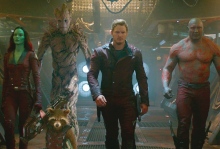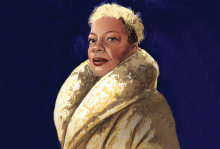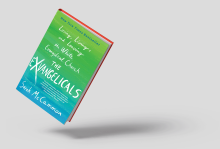Arts & Culture

IN THE CLOSING scenes of Marvel’s original Guardians of the Galaxy, we find our heroes in a tight spot. The group — escaped science experiment Rocket Racoon, giant sentient tree Groot, assassin Gamora, ex-convict Drax, and mercenary Peter Quill — have been grudgingly working together to protect a powerful artifact from falling into the wrong hands. Because they’ve each been pursuing their own agendas instead of working together, they are close to failure. It’s up to Quill (Chris Pratt), to convince them to start working as a team.
“I look around at us, and you know what I see?” he asks them. “Losers.” Noting their incredulous faces, Quill qualifies, “I mean, like, folks who have lost stuff.” He’s right; each of these tentative allies have experienced loss, trauma, and unresolved grief that taught them not to trust others.

COMPLETELY BY COINCIDENCE, travel writer and translator Shahnaz Habib once joined thousands of pilgrims in Lalibela, Ethiopia. Habib’s trip happened to overlap with Ethiopian Christmas, which brings Ethiopian Orthodox Christians from across the country and world to the town, famous for its medieval rock-hewn churches.
Detailing her experience in her book Airplane Mode, a personal history of travel with a sharp eye for the colonial legacies in tourism, Habib calls Lalibela’s churches “marvels of subterranean engineering.” Carved from red volcanic rock, they sit embedded in the ground, connected by tunnels. The complex of structures was built in the 12th century as an homage to Jerusalem, complete with replicas of Christ’s Nativity crib and tomb.
Habib observed as her fellow travelers lined up around the churches to kiss crosses offered by priests: “A kiss at the top of the cross, a kiss at the bottom, a touch of the cross to the forehead. Hundreds of kisses every hour.” She noted the procedural quality of the ritual.
“To lose oneself in a crowd. To walk the beaten path. To wait and be bored,” she writes. “Perhaps what separates the tourist and the pilgrim is not the reasons for their travel but the satisfaction that the pilgrim finds in what frustrates the tourist.”

AUNJANUE ELLIS-TAYLOR, known for such roles as Hippolyta Freeman in the HBO series Lovecraft Country and Mama in The Color Purple (2023), approaches her acting as an artisan, searching for the right tools with which to craft her characters, she told Sojourners’ assistant editor Josina Guess this spring. Two recent films — Origin (2023) and Exhibiting Forgiveness (2024) — feature powerful performances by Ellis-Taylor and tap into her own yearning for a world in which justice and truth prevail.
Origin (written, produced, and directed by Ava DuVernay) is a biographical drama inspired by Pulitzer-winning journalist Isabel Wilkerson’s process of writing Caste: The Origins of Our Discontents (2020). The film depicts a quest for the origins of why we separate ourselves from one another, even though it destroys us physically, spiritually, and politically. For her moving performance as Wilkerson, Ellis-Taylor traveled to Germany and India, tracing Wilkerson’s observations about the connected histories between Nazism, the caste system, and racism in the United States — deepening our understanding of these bitter human wounds.
Exhibiting Forgiveness is an autobiographical film written and directed by artist Titus Kaphar, whose process-oriented works on canvas, sculpture, and film reveal the layered reality between history and the present. In Exhibiting Forgiveness, an artist named Tarrell experiences rising success while haunted by flashbacks of a childhood riddled with addiction and family violence. Ellis-Taylor plays Joyce, the artist’s mother, who begs her son to forgive because “it’s what the Bible says.”
Both films invite viewers to wrestle with themes of reckoning and healing on a personal and societal level. Ellis-Taylor spoke with Guess about the lessons of Origin in this election year, what she sees as the “burdensome” work of Black forgiveness in the face of ongoing harm, and her commitment to speaking and living into truth, including embracing her queer identity while remaining in the Black church. —The Editors

Gospel music is my oasis in troubled times. My colleagues can also attest that it’s the background music by which I conduct most of my work.

As I remember it, I was first introduced to Jamie Grace’s career while listening to a Christian radio show in 2011. At the time, she was a 19-year-old college student majoring in child and youth development, recently signed to a major Contemporary Christian Music (CCM) label, and was less than a year away from being nominated for the 2012 Grammy Award for Contemporary Christian Music Song. She was a Black woman in an industry largely made up of white men; she was open about her diagnoses of Tourette syndrome, attention-deficit/hyperactivity disorder, and obsessive-compulsive disorder at a time when I wasn’t aware of many people who were; and she was a very skilled guitar player, songwriter, and singer. As such, it seemed obvious that she had a bright future in an industry that needed new energy.

Join or Die is described in promotional materials as, “A film about why you should join a club...and why the fate of America depends on it.” Featuring heavy-hitters like former Secretary of State Hillary Clinton, Secretary of Transportation Pete Buttigieg, Surgeon General Vivek Murthy, along with many influential scholars, the film argues that the loneliness epidemic is a threat to democracy and the public health of the nation.

Early in his adult life, Lau-Lavie is outed in a news article as gay, prompting him to move from Israel to New York in search of a spiritual life that makes more sense than his Orthodox heritage.

On June 1, for the North Carolina residents of downtown Durham, the morning’s new mercies came in the form of Chappell Roan’s song “HOT TO GO!” being played from the century-old bell tower of Duke Memorial United Methodist Church.

“ONE OF THE TRADITIONS of St. Patrick is an old prayer that he wrote called ‘St. Patrick’s Breastplate,’” explained Father David Rose of St. Luke’s Episcopal Church in Rincon, Ga., to the half-dozen men who’d gathered around him. “It’s more like an epic poem, like an old epic Celtic poem, but it’s a prayer.”
“I bind unto myself today / the strong Name of the Trinity,” he continued, reciting stanzas of the 1,500-year-old prayer. “By invocation of the same / The Three in One and One in Three / Of Whom all nature hath creation / Eternal Father, Spirit, Word: Praise to the Lord of my salvation / Salvation is of Christ the Lord!”
Father Rose wasn’t addressing his fellows from the pulpit, however, nor were they gathered in the basement or rectory of St. Luke’s. Instead, he was speaking to a group of Dungeons & Dragons players at Savannah Lion Games in Pooler, Ga., at a table covered in rulebooks and dice rather than Bibles and hymnals.
Welcome to Game Church.

IN THE LAST nine months, John Patrick Shanley has had three plays on and off Broadway: revivals of “Doubt” and “Danny and the Deep Blue Sea,” and the debut of “Brooklyn Laundry.” While the timing is completely coincidental, the three plays cover much of his career: “Danny” premiered more than 40 years ago, and “Doubt” recently turned 20.
Despite the decades between them, these plays share a surprisingly consistent take on faith. Though raised Catholic, today Shanley demurs from identifying with any one religion. In a recent interview he told me, “It’s like when you’re among theists, you get handed a piano with 88 keys and told you can only use 13. I think that human spiritual experience is first of all mysterious and second of all, extremely rich and varied. Any reduction is just that, a subtraction from the breathtaking panoply available to us through the history of the spirit.”
In “Danny,” “Doubt,” and “Brooklyn,” God is not a comfort. Instead, Shanley’s characters are confronted with the radical, unavoidable uncertainty of reality — and challenged to go forward anyway. For Shanley, the whole idea of faith demands stripping away anything sentimental or reassuring. It isn’t faith if it isn’t well and truly a leap.

When Girls Govern
The documentary Girls State follows a group of dedicated high school girls as they participate in an immersive mock-government program. At a time when civic norms are being eroded, the film is a fascinating, hopeful, and human portrait of American democracy’s future. Apple TV+

THERE IS SOMETHING outré about summertime sadness. As foliage reaches its lushest form and the sun turns our skin dewy, nature summons its full potential to evoke enchantment. And yet, we often find ourselves standing obstinate in the face of God’s good favor.
Such is the case for Delphine in Éric Rohmer’s 1986 French drama, The Green Ray. Newly separated from her fiancé and ditched by a friend she was supposed to vacation with, Delphine (Marie Ri-vière) is suddenly alone in Paris as the city’s leisure class flees for more temperate summer climates. Failed attempts at companionship find her isolated or, worse, at the mercy of dining companions who take on the role of Job’s friends, psychoanalyzing her disposition and insisting she just needs to get out more. Despite all efforts, Delphine is disenchanted.

IN PEACEBUILDING AND THE ARTS, practical theologians Theodora Hawksley and Jolyon Mitchell ask readers to imagine peace: “It is all too easy to reach for clichés” — doves or peace signs come to mind — or “to think of peace as a sort of absence, a not-happening.” In our violent world, we readily picture conflict and injustice, but not peace or conflict transformation. The arts help us fill this empty space, revealing the true nature of peacebuilding as “an ongoing, dynamic process, a journey that sets human relationships on the road to life.” Through bolstering the moral imagination, the arts rehumanize dehumanized contexts.
Mitchell explains how the arts give us “realistic visions of how to create peace” and foster “an environment in which the ‘moral imagination’ can be cultivated.” He shares the example of Mozambican Anglican Bishop Dinis Sengulane, who, in the mid-’90s, established the Transforming Arms into Tools project after the end of Mozambique’s long civil war. This project asked local artists to “glorify peace” through refashioning decommissioned weapons into art. Compelling works such as “Throne of Weapons” (2001) and “Tree of Life” (2004) emerged: metallic sculptures made from assault rifles welded together in a way that preserved the outlines of the weapons. The “Throne of Weapons” has a back, arms, seat, and legs made clearly from the barrels, triggers, and heels of AK47s. The viewing experience is a dance between the parts and the whole, which underscores the meaning of the project itself. The sculptures represent the specific horrors of the past and broader hope born from peacebuilding. Displayed in public places in the U.K., these works have served as a caution against gun violence and an inspiration to activist-artists across the globe.

CHRISTIANITY IN THE U.S. often resembles a politically charged, dysfunctional family tree, its branches twisting and tangling as factions clash. When evangelical Christians leave their branch — or the entire tree — some continue to wrestle with the ideas that shaped their lives. NPR political correspondent Sarah McCammon portrays those wrestlers with care in The Exvangelicals: Loving, Living, and Leaving the White Evangelical Church.
“Exvangelical” and “deconstruction” are buzzwords in some corners of Christian internet. The former was coined by Exvangelical podcast host Blake Chastain; McCammon defines the latter as “the often painful process of rethinking an entire worldview and identity that was carefully constructed” within conservative faith traditions.

AFTER MY GRANDMA died, I began to pay attention to cardinals. She loved watching birds through her kitchen windows, and the memorial cards at her funeral displayed an illustration of a cardinal. After that, every cardinal I saw felt like a message sent by my grandma from heaven, reminding me that she was looking out for me, and that she wasn’t really gone, not fully.
So, when I listened to “Cardinal,” the first track on Kacey Musgraves’ latest album Deeper Well, I felt like Musgraves wrote the song for me.
“Cardinal,” she sings, “are you bringing me a message from the other side?”
With songs about finding peace and falling in love, growing up and maturing, Deeper Well is spiritually grounding. A reminder to slow down, go outside, and appreciate what we have.

I was welcomed home by the me
I’d always tried to be—
more rainbow than thunderclap,
no more worry-do-worry-do.

A WILL IS an important document that protects your family and ensures financial security for children who have yet to pay back the 300 grand you spent on each of them growing up. You definitely should not wait until you’re 73 to write one. In my case, I was waiting for the wisdom that comes with age. Failing that, I was also waiting for the lawyer we chose to grow up and go to law school. Because, when we first met him, I thought he was a teenager.
It’s like when I go to the doctor these days and she looks like she’s just been dropped off at soccer practice by her mom. Nothing like the white-haired doctor who used to frighten me with dire predictions of the health problems that every aging man confronts. But now that all those predictions have come true for me, I need to make my will.

Fury Road drew on Exodus imagery in Furiosa’s flight from the Citadel, leading her people to a promised land. No surprise, then, that the earlier beats of Moses’ story have striking parallels to Furiosa’s backstory.

In ABC’s workplace comedy Abbott Elementary, Barbara Howard (Sheryl Lee Ralph) provides one example of what it looks like for Black Christian women to live out their faith in their everyday lives.

In comic-book writer Tom King’s run on Wonder Woman, Diana has been fighting a battle not just of fists but of ideologies.